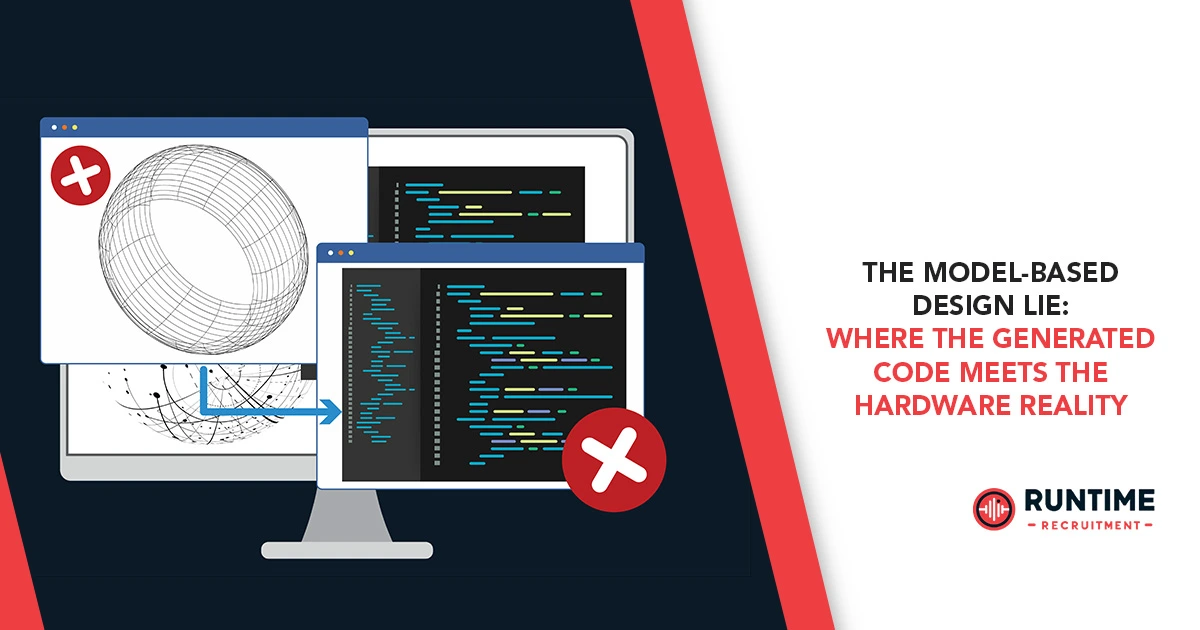For years, Model-Based Design (MBD) has been lauded as the silver bullet for embedded systems development. The promise is enticing: abstract away the complexities of low-level coding, accelerate development cycles, and produce perfect, bug-free code with the click of a button. For many, MBD represents a utopian future where engineers spend their time on high-level system design and algorithm innovation, while the mundane, error-prone task of manual coding is left to the machines.
But as any seasoned embedded engineer knows, the reality is far more nuanced. The gleaming facade of MBD hides a deep and uncomfortable truth—a lie perpetuated by marketing and wishful thinking. The moment that pristine, automatically generated code is deployed onto a real-world hardware target, the illusion shatters. What we’re left with is a gap, a chasm of reality where the perfect model collides with the imperfect, messy world of silicon, clocks, and interrupts. This article isn’t a condemnation of MBD; it’s a call to confront its limitations, to bridge the gap, and to reclaim the core principles of embedded engineering that MBD’s marketing often obscures.
The Perfect Model vs. The Imperfect World
At its core, MBD is about creating a high-level, graphical representation of a system’s behavior. Using tools like MATLAB/Simulink or LabVIEW, engineers can build block diagrams that define control algorithms, signal processing chains, and state machines. The beauty of this approach is its visual nature, allowing for rapid prototyping, simulation, and verification long before a single line of C code is written.
However, a model is, by its very nature, an abstraction. It’s a simplified view of a complex reality. The lie of MBD begins here, with the assumption that this abstraction perfectly maps to the physical world. In a simulation, a “perfect” digital signal travels from one block to another with zero latency, an ideal clock provides perfectly timed ticks, and floating-point arithmetic is exact and consistent.
The real world, as we know, is anything but perfect.
The Problem of Precision: Floating-Point Folly
One of the most common collisions between the model and the hardware is the matter of numerical precision. A Simulink model might run with double-precision floating-point numbers, offering a massive dynamic range and fine granularity. The generated code, however, is often destined for a microcontroller with a resource-constrained FPU (Floating-Point Unit) or, worse, no FPU at all.
When the code generator translates a high-precision model into single-precision floats or, even more challenging, fixed-point arithmetic, the assumptions of the model are fundamentally broken. Numerical errors, quantization noise, and overflow/underflow issues that were non-existent in the simulation suddenly become real, tangible bugs. A seemingly innocuous calculation in the model can introduce subtle but critical errors in the generated code, leading to system instability, control loop jitter, or catastrophic failures.
Engineers are then faced with the task of debugging these discrepancies—a process that requires not just an understanding of the model, but a deep, intimate knowledge of the target hardware’s numerical capabilities. The “perfect” code requires imperfect, manual intervention to become viable.
The Code Generation Black Box
The central pillar of the MBD promise is automatic code generation. The toolchain takes your graphical model and spits out C/C++ code. This is a tremendous time-saver, but it also creates a major problem: the code is often a black box.
For the pure MBD evangelist, the generated code is a “verifiable artifact” that shouldn’t need to be inspected. “Trust the tool,” they say. But what happens when things go wrong? When a system isn’t behaving as expected and you’re staring at thousands of lines of convoluted, un-commented, machine-generated code, the trust quickly evaporates.
Obfuscation and Debugging Nightmares
The generated code, while functionally correct according to the tool’s internal logic, is not written with human readability in mind. It’s often a tangled mess of temporary variables, goto statements, and arcane function names. Debugging a timing issue or a memory corruption bug in this environment is a special kind of hell. A breakpoint in the original model doesn’t map cleanly to a line of code in the final executable, and a call stack trace is a bewildering journey through machine-generated subroutines.
Engineers are often forced to reverse-engineer the generated code to understand its behavior, a process that defeats the very purpose of MBD. The “black box” approach breaks down the moment a problem arises that can’t be fixed by simply tweaking a parameter in the model.
The Integration Challenge: When Generated Code Meets Legacy Code
In the real world, a system is rarely built from a single, monolithic model. Most embedded projects require integrating the generated code with existing, hand-written firmware. This could be legacy code for device drivers, a real-time operating system (RTOS), or communication stacks. This is where the MBD illusion truly breaks down.
The generated code often has specific assumptions about its execution environment, such as a main loop that it fully controls or a deterministic scheduler. Integrating this with an existing RTOS, which has its own tasking model, synchronization primitives, and resource management, is a non-trivial exercise. It requires meticulous manual work to create wrappers, APIs, and interfaces to allow the generated code to play nice with the rest of the system. This “glue code” is written by hand and is a potential source of bugs, race conditions, and integration failures. The promise of “no manual coding” is revealed as a half-truth; the manual coding is simply pushed to the boundaries of the system.
The Hardware-in-the-Loop Reality
MBD proponents often point to Hardware-in-the-Loop (HIL) testing as the ultimate verification step, where the generated code running on the real hardware is tested against a simulated plant model. This is an incredibly powerful technique, but it doesn’t eliminate all problems.
HIL testing is a powerful tool for catching discrepancies between the model and the hardware, but it is not a cure-all. It can reveal timing issues, precision errors, and unexpected hardware behavior. However, the simulation of the “plant” (the physical system being controlled) is itself an abstraction. If the plant model doesn’t accurately reflect the real world, the HIL test will pass, but the final product will fail in the field. This is particularly true for complex, non-linear systems or those with highly variable environmental factors.
The true challenge is that MBD can sometimes lead to a false sense of security. The model passes the MIL (Model-in-the-Loop) test, the SIL (Software-in-the-Loop) test, and the HIL test. The code is “perfect.” But what about the things the model didn’t account for? An unhandled interrupt, a brown-out event, a hardware peripheral that behaves differently under extreme temperature, or a sensor with a noisy signal. The model, and by extension the generated code, knows nothing of these realities.
Reclaiming the “Embedded” in Embedded Systems
So, is MBD a lie we should abandon? Absolutely not. MBD is a powerful, transformative tool. The “lie” isn’t in its capabilities, but in the oversimplified marketing narrative that denies the fundamental realities of embedded engineering. The true value of MBD is not in its ability to eliminate manual coding, but in its capacity to empower engineers with new tools for design, simulation, and early-stage verification.
The path forward is not to blindly trust the generated code, but to master it. Here’s how we can bridge the gap and leverage MBD effectively:
1. Understand the Target Hardware from the Start.
Don’t design a model in a vacuum. Your model’s architecture must be a direct reflection of your hardware’s capabilities. If you’re using a fixed-point processor, design a fixed-point model. If your target is an 8-bit microcontroller, use a fixed-step solver that matches its timing constraints. The hardware constraints should be the foundation of your model, not an afterthought.
2. Master the Toolchain.
Know your code generator’s quirks, its limitations, and its configuration options. Spend time understanding the generated code. Learn how the tool handles data types, memory allocation, and task scheduling. This knowledge is your decoder ring for the black box.
3. Design for Interoperability.
Architect your system to have clear, well-defined boundaries between the generated code and the hand-written code. Use a clean API and a message-passing architecture to ensure that the two worlds can coexist without tight, fragile dependencies.
4. Embrace Manual Optimization.
After code generation, be prepared to get your hands dirty. Profile the generated code on your target hardware. Identify bottlenecks and areas for manual optimization. This might involve rewriting a critical subroutine in assembly or C, or adjusting the model to generate more efficient code. This is not a failure of MBD; it’s a necessary step to produce production-ready, performant firmware.
5. Prioritize Robust Verification.
Extend your verification beyond the simulated world. Develop comprehensive test suites that run on the actual hardware. Use unit tests, integration tests, and stress tests that push the system to its limits, exposing timing-related bugs, memory leaks, and other real-world problems that a simulation might miss.
The Bottom Line
The lie of Model-Based Design is that it promises to replace the embedded engineer, but the reality is that it makes a good embedded engineer even more valuable. The new MBD-proficient engineer isn’t just a block diagram builder; they are a systems architect who understands the intricate dance between abstract models and physical reality. They are fluent in both the high-level graphical language of the model and the low-level gritty details of the hardware. They know when to trust the generated code and, more importantly, when to question it.
This is the new frontier of embedded engineering. The challenge isn’t just in creating a perfect model, but in making sure that its perfect digital soul can be safely and efficiently embodied in a very imperfect, very real piece of hardware.
Is your team struggling to bridge the gap between model and hardware?
Connect with RunTime Recruitment. We specialize in placing expert embedded engineers who understand the real-world challenges of MBD and can deliver robust, production-ready solutions. We connect talent with opportunity.









